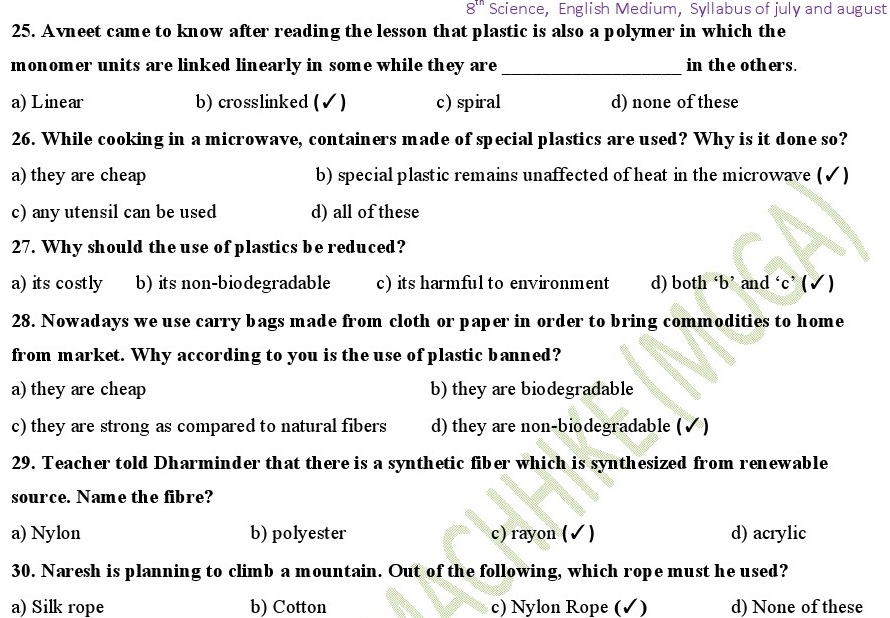Synthetic Fibres and Plastics
Question 1.
Explain why some fibres are called synthetic.
Answer:
Some fibres are called synthetic fibres because they are made by man using
chemicals.
Question 2.
Mark (✓) the correct answer.
Rayon is different from synthetic fibres because
(a) it has a silk-like appearance.
(b) it is obtained from wood pulp.
(c) its fibres can also be woven like those of natural fibres.
Answer:
(b) it is obtained from wood pulp.
Question 3.
Fill in the blanks with appropriate words.
(a) Synthetic fibres are also called ____ or ____ fibres.
(b) Synthetic fibres are synthesised from a raw material called _____
(c) Like synthetic fibres, plastic is also a _____
Answer:
(a) man-made, artificial fibres
(b) petrochemicals
(c) polymer
Question 4.
Give examples which indicate that nylon fibres are very strong.
Answer:
The following examples indicate that nylon fibres are very strong.
(i) They are used for making parachutes and ropes for rock climbing.
(ii) They are used in making seat-belts, fishing nets, tyre cord, a string for
sports rackets and musical instruments.
Question 5.
Explain why plastic containers are favoured for storing food.
Answer:
Plastic containers are favoured for storing food because of the following
reasons:
(i) the plastics do not react with the food stored in them.
(ii) the plastics are lightweight and are strong.
(iii) they are easy to handle and safe.
Question 6.
Explain the difference between thermoplastic and thermosetting plastics.
Answer:
|
Thermoplastics |
Thermosetting plastics |
|
(i)
These plastics softened on heating and can be bent easily. |
(i)
These plastics when moulded once, can’t be softened again. |
|
(ii)
They do not lose their plasticity. |
(ii)
They lose their plasticity. |
|
(iii)
Examples are polyethene, PVC, etc. |
(iii)
Examples are bakelite and melamine. |
Question 7.
Explain why the following are made of thermosetting plastics.
(a) Saucepan handles
(b) Electric plugs/switches/plug boards
Answer:
(a) Since, thermosetting plastics are a bad conductor of heat and do not get
heated up while cooking, they are used for making saucepan handles.
(b) Since thermosetting plastics are a bad conductor of electricity and the
electric current does not pass through such plastics, they are used for making
electric plugs/switches/plugboards.
Question 8.
Categories the materials of the following products into ‘can be recycled’ and ‘cannot
be recycled’.
Telephone instruments, plastic toys, cooker handles, carry bags, ballpoint
pens, plastic bowls, plastic covering on electrical wires, plastic chairs,
electrical switches.
Answer:
|
Can be recycled |
Cannot be recycled |
|
Plastic
toys carry bags, plastic bowls, plastic covering on electrical wires, plastic
chairs. |
Telephone
instruments, cooker handles, ballpoint pens, electrical switches. |
Question 9.
Rana wants to buy shirts for summer. Should he buy cotton shirts or shirts made
from synthetic material? Advise Rana, giving your reason.
Answer:
He should buy cotton shirts. This is because cotton has more capacity to hold
moisture than synthetic clothes. In summers we have extensive sweating which is
easily soaked by cotton shirts and hence, cotton clothes are much better than
the clothes made from synthetic material.
Question 10.
Give examples to show that plastics are non-corrosive in nature.
Answer:
The literal meaning of non-corrosive is resistant to get destroyed by chemical
action.
Following are the examples that show that plastics are non-corrosive in nature.
- Plastic
containers do not react with items stored in it.
- They
do not get rusted when exposed to moisture and air.
- They
do not decompose when left in open for a long period.
Question 11.
Should the handle and bristles of a toothbrush be made of the same material?
Explain your answer.
Answer:
No, the handle and bristles of a toothbrush should not be made of the same
material. This is because our gums are soft and the bristles should be made of
soft material so that it does not harm the gums. On the other hand, the handles
should be made up of hard material so that it can give a firm grip.
Question 12.
‘Avoid plastics as far as possible’. Comment on this advice.
Answer:
Plastics must be avoided as far as possible. The materials made of plastics are
non-biodegradable. The use of plastics has a bad effect on the environment.
When the plastics are burnt, it releases a lot of poisonous fumes into the
atmosphere causing air pollution. These plastic materials when eat up by the
animals (like cows), choke their respiratory system. This can cause death of
these animals. The waste plastic articles thrown here and there carelessly get
into dirty water drains and sewers, and block them. In a nutshell, plastics can
be considered a threat to our environment.
Question 13.
Match, the terms of column A correctly with the phrases given in column B.
|
A |
B |
|
(i)
Polyester |
Prepared
by using wood pulp |
|
(ii)
Teflon |
Used
for making parachutes and stockings |
|
(iii)
Rayon |
Used
to make non-stick cookware |
|
(iv)
Nylon |
Fabrics
do not wrinkle easily |
Answer:
(i) (d)
(ii) (c)
(iii) (a)
(iv) (b)
Question 14.
‘Manufacturing synthetic fibres is actually helping the conservation of
forests’. Comment.
Answer:
In the manufacturing of synthetic fibres, we use only chemical substances and
no natural materials, thus, in turn, we conserve forests.
Question 15.
Describe an activity to show that thermoplastic is a poor conductor of
electricity.
Answer:
Arrange a circuit as shown in the given figure. Leave a gap between two ends of
the wire. Place a ther-moplastic in the gap. Observe the bulb.
It is observed that the bulb does not glow. This shows that thermoplastic is a
poor conductor of electricity.






